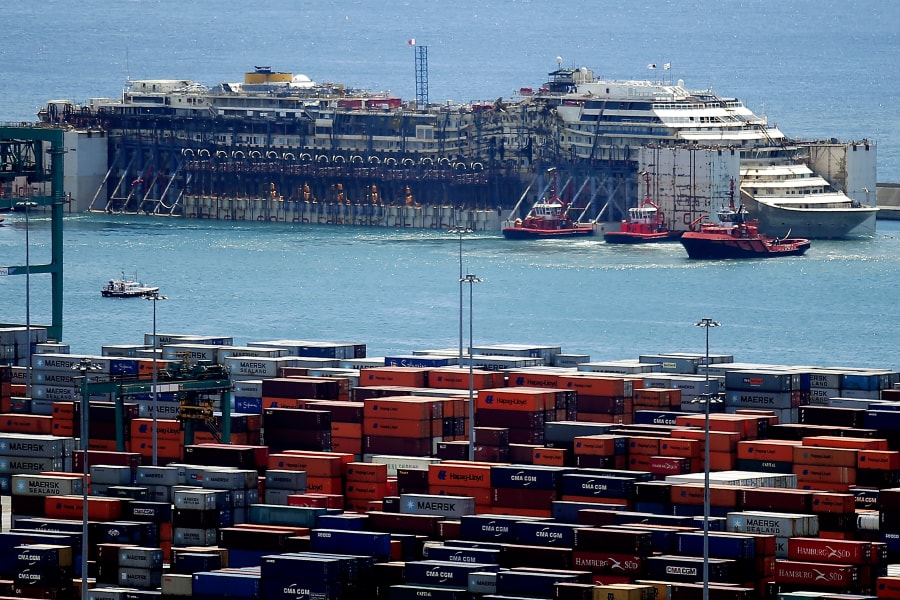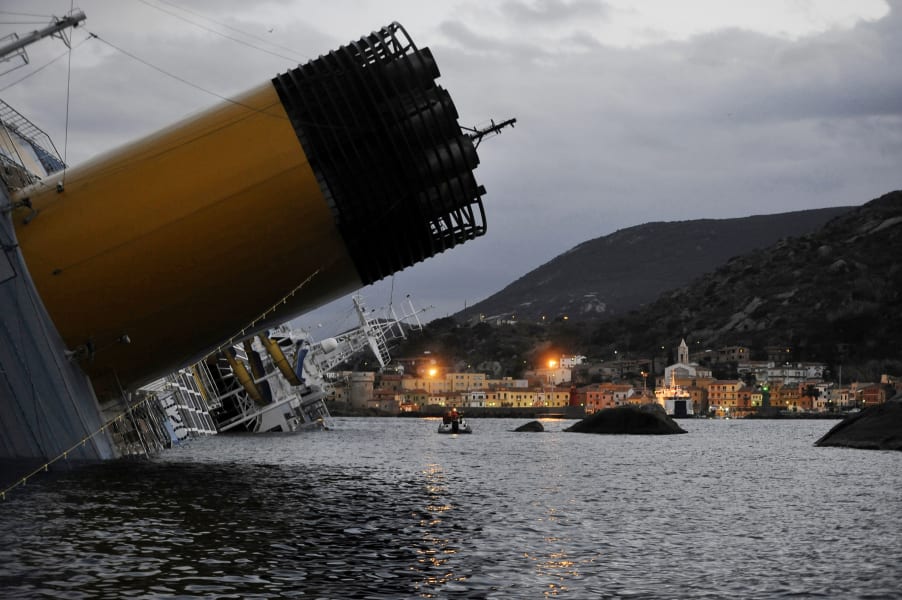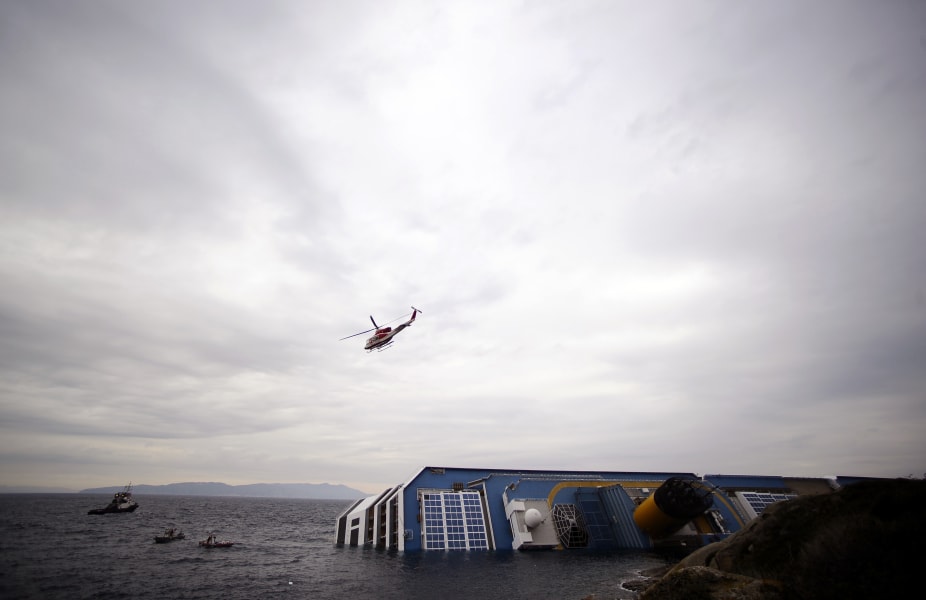Share


1 of 44
The refloated wreck of the Costa Concordia is towed to the Italian port of Genoa on Sunday, July 27, to be scrapped, ending the ship's final journey two and a half years after it capsized at a cost of 32 lives. MARCO BERTORELLO/AFP/Getty Images
The Concordia is towed into the port of Genoa on July 27. GIUSEPPE CACACE/AFP/Getty Images
Tugboats tow the wreck of the Costa Concordia as it leaves Italy's Giglio Island on Wednesday, July 23. Courtesy of the Italian Civil Protection Department/AP
A view from a porthole shows the wreck of the Costa Concordia as it's being towed on July 23. It'll take about two years to dismantle the massive cruise liner.
TIZIANA FABI/AFP/Getty Images
TIZIANA FABI/AFP/Getty Images
The Costa Concordia cruise ship sits in front of the harbor of Giglio Island after it was refloated using air tanks attached to its sides on Tuesday, July 22. Environmental concerns prompted the decision to undertake the expensive and difficult process of refloating the ship rather than taking it apart on site. ANDREAS SOLARO/AFP/Getty Images
The ship's name appears above the water on Monday, July 21. The ship is expected to arrive in Genoa on Sunday, August 27. TIZIANA FABI/AFP/Getty Images
Tugboats pull the Costa Concordia after the first stage of the refloating operation on Wednesday, July 16. Laura Lezza/Getty Images
A small boat passes by the wreckage on Tuesday, July 15. GIUSEPPE CACACE/AFP/Getty Images
Water is expelled from the caissons hooked onto the Costa Concordia on Monday, July 14. The ship will be towed north to the port in Genoa, Italy. VINCENZO PINTO/AFP/Getty Images
Thirty-two people died when the 114,000-ton vessel, seen here on July 14, ran aground off Giglio in January 2012. VINCENZO PINTO/AFP/Getty Images
In December 2013, crews managed to rotate the ship into an upright position. GIUSEPPE CACACE/AFP/Getty Images
To float the ship, seen here on Thursday, June 26, crews attached 30 steel tanks to fill with compressed air. FILIPPO MONTEFORTE/AFP/Getty Images
Ship captain Francesco Schettino, left, returned to the Concordia in February for the first time since he ran the liner aground. He is on trial on charges of manslaughter, causing a maritime disaster and abandoning ship with passengers still on board. He denies wrongdoing. FILIPPO MONTEFORTE/AFP/Getty Images
Experts inspect the ship's damage in January. They boarded the vessel to collect new evidence, focusing on the ship's bridge and the onboard elevators. Laura Lezza/Getty Images
The wreckage of the Costa Concordia cruise ship sits near the harbor of Giglio on Tuesday, September 17, after a salvage crew rolled the ship off its side. VINCENZO PINTO/AFP/Getty Images
The ship had been lying on its side for 20 months off the island of Giglio. Here, members of the U.S. company Titan Salvage and the Italian marine contractor Micoperi pass by the wreckage. VINCENZO PINTO/AFP/Getty Images
Damage to the right side of the ship is apparent in September. Andrew Medichini/AP
Using a vast system of steel cables and pulleys, maritime engineers work on Monday, September 16, to hoist the ship's massive hull off the reef where it capsized. AP Photo/Andrew Medichini
The project to upright the Costa Concordia continues on September 16. The nearly $800 million effort reportedly is the largest maritime salvage operation ever. Marco Secchi/Getty Images
A water line marks the former level of the stricken Costa Concordia as the salvaging operation continues on September 16. The procedure, known as parbuckling, has never been carried out on a vessel as large as Costa Concordia before. Laura Lezza/Getty Images
Members of Titan and Micoperi work at the wreck site early on September 16. VINCENZO PINTO/AFP/Getty Images
Technicians work to salvage the half-submerged ship in July 2013. VINCENZO PINTO/AFP/Getty Images
Giant hollow boxes have been attached to the side of the ship, seen here in May 2013. Attempts to refloat the ship will be aided by the compartments. VINCENZO PINTO/AFP/Getty Images
A commemorative plaque honoring the victims of the cruise disaster is unveiled in Giglio on January 14, 2013. Laura Lezza/Getty Images
Survivors, grieving relatives and locals release lanterns into the sky in Giglio after a minute of silence on January 13, 2013, marking the one-year anniversary of the shipwreck. The 32 lanterns -- one for each of the victims -- were released at 9:45 p.m. local time, the moment of impact. Laura Lezza/Getty Images
A man holds an Italian flag on his balcony overlooking the port of Giglio on January 13, 2013. FILIPPO MONTEFORTE/AFP/Getty Images
A man works in front of the shipwreck on January 12, 2013. FILIPPO MONTEFORTE/AFP/Getty Images
A couple walks along the port of Giglio at night on January 12, 2013. FILIPPO MONTEFORTE/AFP/Getty Images
A man sits in his boat in front of the half-submerged cruise ship on January 8, 2013. FILIPPO MONTEFORTE/AFP/Getty Images
Cranes and floating decks surrounding the ship light up the dusk sky on January 9, 2013. FILIPPO MONTEFORTE/AFP/Getty Images
Workers stand on the edge of the ship on January 8, 2013. FILIPPO MONTEFORTE/AFP/Getty Images
A crew passes by the hulking remains on January 7, 2013. FILIPPO MONTEFORTE/AFP/Getty Images
People enjoy a day in the sun with a view of the cruise liner on July 1, 2012. Guido MARZILLA/Gamma-Rapho via Getty Images
Military rescue workers approach the cruise liner on January 22, 2012. FILIPPO MONTEFORTE/AFP/Getty Images
Members of the Italian coast guard conduct a search-and-rescue mission on January 21, 2012. Laura Lezza/Getty Images
Rescue operations to search for missing people resumed on January 20, 2012, after being suspended for a third time as conditions caused the vessel to shift on the rocks. Ufficio Stampa Gruppo Carabinieri Subaquei via Getty Images
The Costa Serena, the sister ship of the wrecked Costa Concordia, passes by on January 18, 2012. VINCENZO PINTO/AFP/Getty Images
A bird flies overhead the Costa Concordia on January 18, 2012. Rescue operations were suspended as the ship slowly sank farther into the sea. Tullio M. Puglia/Getty Images
The ship was sailing a few hundred meters off the rocky Tuscan coastline. Tullio M. Puglia/Getty Images
An Italian coast guard helicopter flies over Giglio's harbor on January 16, 2012. ANDREAS SOLARO/AFP/Getty Images
Rescuers search the waters near the stricken ship on January 16, 2012. FILIPPO MONTEFORTE/AFP/Getty Images
The Concordia, pictured on January 15, 2012, was on a Mediterranean cruise from Rome when it hit rocks off the coast of Giglio. FILIPPO MONTEFORTE/AFP/Getty Images
The ship starts keeling over early on January 14, 2012. Evacuation efforts started promptly but were made "extremely difficult" by the position of the listing ship, officials said. Luca Milano/AFP/Getty Images
Rescued passengers arrive at Porto Santo Stefano, Italy, on January 14, 2012. The Costa Concordia was carrying 3,200 passengers and 1,000 crew members. FILIPPO MONTEFORTE/AFP/Getty Images



















































